SECTION A
1. Give one of the functions of the feelers of an insect.
2. Draw a simple diagram of a red blood cell in the space provided below.
3. Name one of the breeds of pigs commonly kept in Uganda.
4. Why is a person suffering from diarrhoea given treatment for dehydration?
5. State any one practice which may prevent hook-worm infection.
6. Give one example of a non-green plant which reproduces by means of spores.
7. State the most important part of the central nervous system.
8. State one way in which a spider is similar to a cockroach.
9. In which one way is the retina of the human eye similar to that of the film of a camera.
10. In the diagram below, what class of lever is represented?
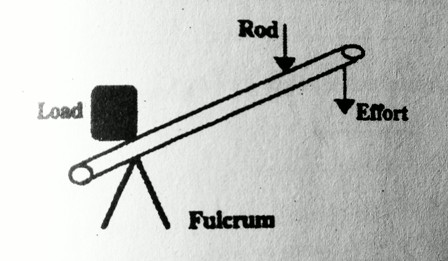
11. What food nutrients are leguminous crops rich in?
12. Give one of the functions of the human liver.
13. Which body system is commonly affected any polio?
14. Why would animals in a paddock system not easily be attacked by East Coast fever?
15. What is the immediate result of fertilisation in both plants and animals?
16. Which type of sheep is reared for wool?
17. What condition is caused by shortage of red blood cells in the human body?
18. How does the lens shown below affect light rays?
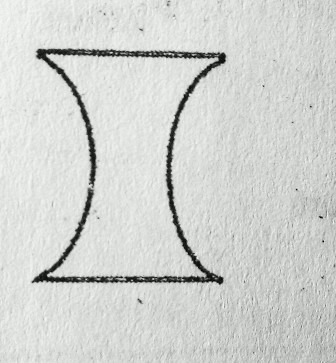
19. Which big mammal lives its whole life in water?
20. State the first stage of soil formation from rocks.
21. Why is it important to look left, right then left again before crossing the road?
22. What is the importance of human teeth in the digestion of food?
23. What type of electricity is obtained by rubbing a plastic material against hair woollen cloth?
24. Apart from contour ploughing, strip cropping and mulching, give one other practice which is useful for soil conservation on a hilly ground.
25. What happens to the blood as it passes through the kidney?
26. What type of change occurs to an egg which has been left in boiling water for more than ten minutes?
Use the diagram of a leaf below to answer questions 277 and 28.
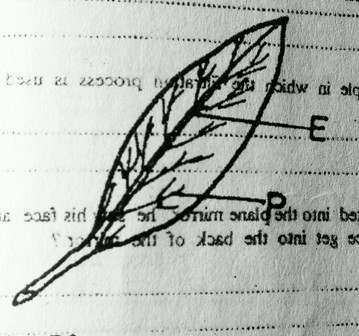
27. What is the part marked P?
28. Give one of the functions of part E.
29. Why do you think photosynthesis is not likely to take place at night?
30. State any one physical change which occurs in female adolescents but does not occur in the male ones.
31. Why is it dangerous to stay near someone who is smoking?
32. Why is osmosis an important process for plants?
33. What is the danger of taking drugs which are not prescribed by a health worker?
34. Give one example in which the filtration process is used at home.
35. When Peter looked into the plane mirror, he saw his face at the back of the mirror. How did his face get into the back of the mirror?
36. Why is it advisable for parents to take their children for immunisation?
37. Why should girls avoid teenage pregnancy?
38. How can water vapour be turned into liquid?
39. Why is it not advisable t use water to put off fire caused by petrol?
40. What is the importance of keeping clothes clean?
SECTION B
41. The diagram below shows glass tubes of the same size with water at different levels as indicated. Study them and answer the questions that follow.
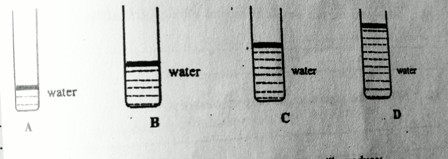
a) If each tube is blown separately, which one will produce:
b) What will happen to the sound produced by tube A if water is increased to the level of tube D?
c) What will happen to the sound produced by each of the tubes if water was replaced by same quantity of milk?
42. The diagram below is of a maize grain. Study it and answer questions (a) to (d) which follow.
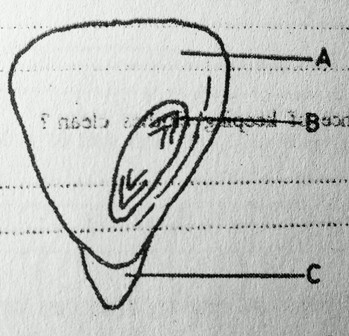
a) How is the part marked C useful to the grain?
b) What does the part marked B become during germination?
c) What is the importance of the part marked A.
d) Which of the marked part is not important in germination?
43. A mill bug is a common crop pest.
a) Name any two vegetable crops it affects:
b) What can be done to prevent it from attacking the crops you have named in (a) above?
c) What natural method controls mill bug pests in a garden?
44. a) What is a magnet?
b) Give an example of how a doctor in a hospital can use a magnet.
45. When measles attacks a child, there are signs and symptoms.
a) Give an example of:
i) A sign of measles
ii) Symptom of measles
b) In which way can measles be prevented from attacking a baby?
c) Why is it important to give a child suffering from measles plant of fluids to drink?
46. a) Give the type of chicken reared for:
i) meat
ii) eggs
b) Suggest two ways you would care for chicken to improve upon their egg production.
47. a) Name one practice which increases the spread of biliharzia.
b) Which vector is important in the spread of biliharzia?
c) Give any two ways of preventing the spread of biliharzia.
48. a) Draw two dry cells arranged correctly and ready to give light in a bulb.
b) If you get a new torch with new dry cells and a new working bulb in place, but when you switch it on the bulb does not light.
Suggest any two possible problems with torch.
49. a) What is First Aid?
b) Why would it be dangerous for a boy of eleven years to try to remove an adult, who is near drowning, from water?
c) Suggest two things the boy in (b) above should do to save the adult from drowning.
50. The diagram below is of a fish. Study it and answer the questions which follow.
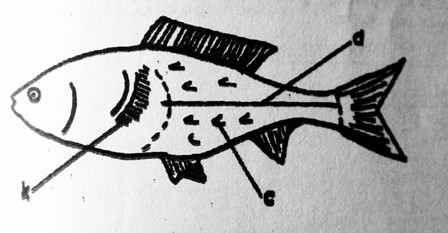
a) Mark with letter P, the part which enables the fish to move forwards.
b) What is the function of part marked C?
c) Complete the table to compare parts marked K and D to those of a goat.
| Part of fish | Name the similar part in a goat |
|
i) K ii) D |
.................................................. .................................................. |
51. a) What is a mixture of two or more metals?
b) Give one example of a common mixture of petals.
c) Apart from parting, give any other method of preventing a metal object from rusting.
52. The diagram below shows the alimentary canal of a bird. Use it to answer the questions that follow:
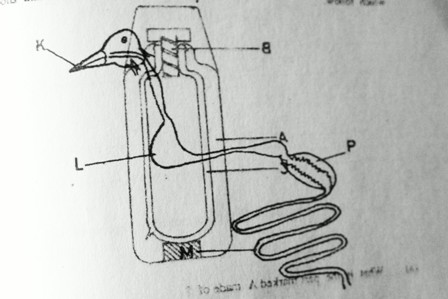
a) What does the bird use part K for?
b) What is function of part L?
c) What takes place in the part marked P?
d) How is part M useful to the bird?
53. The diagram below is of a domestic item. Study it and answer the questions which follow.
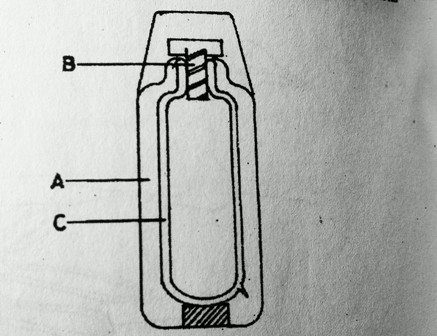
a) What is the part marked A made of?
b) What is the function of the part marked C?
c) Why is part useful in this item?
d) Why is it that many homes do not use this item?
54. a) State any two qualities of an essential drug.
b) Give any two advantages of laboratory manufactured drugs over traditional drugs.
55. a) If the temperature of tea which is 450C reduces by 150C, what will be the temperature of the tea?
b) Change your answer in (a) above to Fahrenheit scale.
